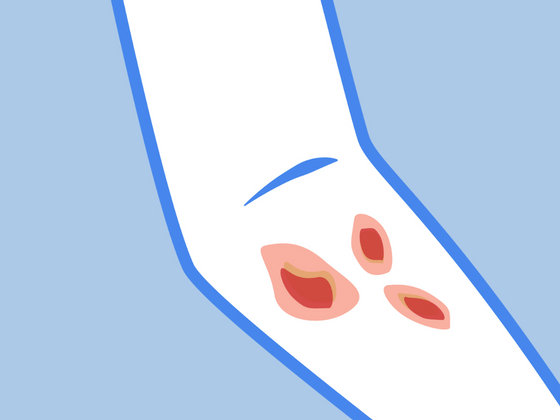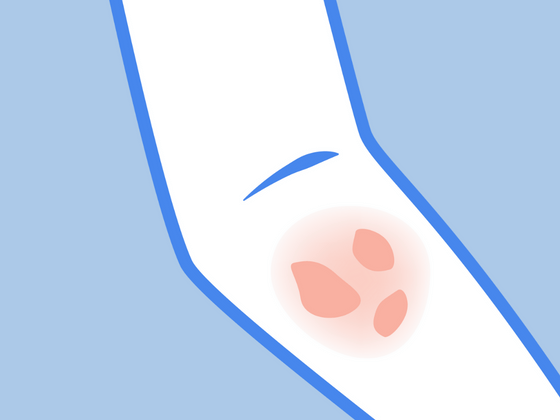Eczema is a chronic skin condition that’s characterized by rough, red, dry, and extremely itchy patches of skin.
While it typically develops in childhood, it can affect people of all ages, ethnicities, and backgrounds. Parents dealing with infant eczema may find specialized eczema cream for babies helpful for managing symptoms. A very common condition, it affects approximately 10-20% of the global population.
If you’re dealing with eczema, you may be wondering ‘how does eczema look when it's healing’? Read on to discover what you can expect on your healing journey.
Please keep in mind that although what we discuss in this post can relieve eczema, we are in no way medical professionals. If you’re experiencing severe eczema symptoms like an infection, it is best to seek medical advice immediately.
What Does Eczema Look Like?
Although there are several different types of eczema, each with their own unique characteristics, there are some general signs to watch out for. Mainly, these include red patches of itchy, rough, and flaky skin.
That being said, it’s important to note that symptoms may vary from person to person, and fluctuate in terms of intensity. For example, you may go through periods of intense flare ups and others where symptoms are barely noticeable. If harmful scratching occurs, the skin may crack or bleed which can increase the risk of infection.
What Triggers Flare Ups?
People with eczema have a damaged skin barrier that has trouble retaining moisture. This is what causes the skin to be dry, and subsequently, itchy. Natural moisturizers like beef tallow cream can help restore this barrier function.The skin barrier is also highly sensitive which means that an eczema flare up can be triggered by a variety of factors, many of them common household objects.
Some common eczema triggers can include pet fur, sweat, extreme weather, dust mites, ingredients found in beauty products, harsh laundry products (which is why using detergent for sensitive skin is important) and even the food you eat.
How Long Do Flare Ups Last?
The length of your flare up will vary from person to person and will depend on what caused the flare up to occur. For example, if a flare up is triggered by an allergic reaction, it may last longer.
If your eczema is triggered by direct contact with a certain substance, it may disappear once contact is removed or within a few weeks of treatment.
Each person is unique which means the healing stages will be different for everyone. The important thing is to determine the underlying cause of the flare up and then take the necessary steps to reduce or remove whatever is triggering the reaction.
Stages of Skin Healing Eczema
It’s important to note that there is no set timeline for healing eczema. As well, the healing journey isn’t always a straight path. For most people, there will be good days and bad days, making it important to be patient with the process.
Acute: In the beginning phase of an acute eczema rash, you’ll notice intense itchiness. This type of short-term eczema usually lasts for a few weeks. It develops as a result of the skin coming into contact with an irritating substance.
Subacute: This is a transitional phase between acute and chronic eczema. Skin may begin to appear flaky or scaly, and the borders of the rash may lose some of their definition. Itchiness may feel more like a burning or stinging sensation.
Chronic: Chronic eczema is long-lasting. Accompanied by the return of intense itchiness, the skin may also become darker or discolored. For some, the skin may develop a thick leathery look. This is known as lichenification.
How to Treat Eczema at Home
To soothe your itchy skin, we recommend using a natural moisturizer such as this Organic Manuka Skin Soothing Cream or other gentle eczema cream options. Made with just 6 ingredients, it’s sure to hydrate even the driest of skin and provide some much-needed itch relief.
We also recommend trying wet wrap therapy. This easy-to-do at home treatment, involves lathering the affected area of your skin with a natural cream, then adding a wet layer of clothing overtop, followed by a dry layer. This helps the emollient better permeate the skin. Leave the wet wrap on overnight or for a minimum of 2 hours. These Remedywear™ Sleeves for babies to adults make a great choice for wet wrapping.
Finally, if you suspect food is triggering your eczema, why not try an elimination diet? This involves removing certain foods from your diet for a set amount of time (usually a month) and then slowly incorporating them back in to see which caused a reaction.








